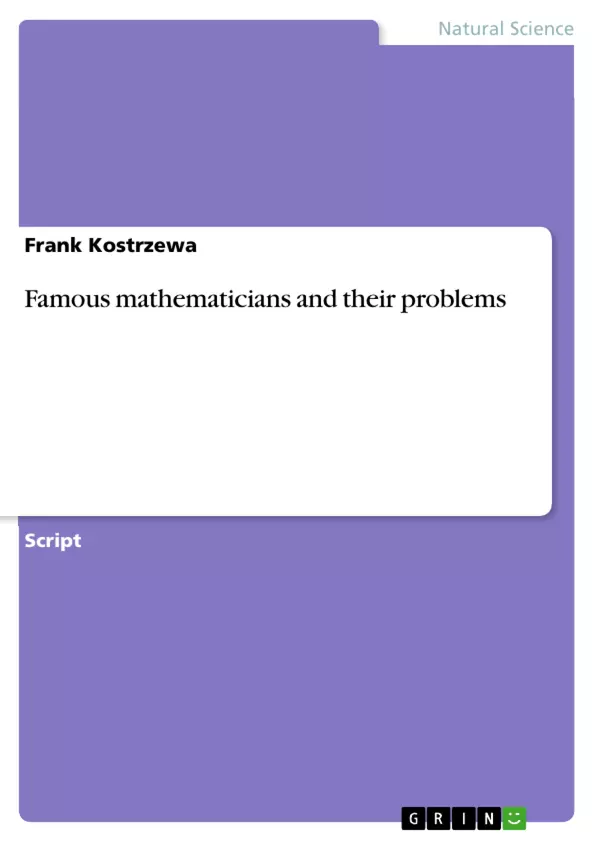In der folgenden Ausarbeitung werden einige zentrale mathematische Probleme und ihre Lösungsansätze beschrieben, u.a.: Zahlensysteme, Ungelöste Probleme der Antike, Befreundete Zahlen und pythagoreische Triple, Vollkommene Zahlen, Der Goldene Schnitt, Wahrscheinlichkeitsrechnung nach Pascal, Fibonacci-Zahlen, Goldbach-Vermutung, Primzahlen, Möbius-Funktion.
Table of Contents
- The Ishango bone
- The calculating system of the Babylonians
- The unsolvable mathematical problems of the ancient world:
- The doubling of the cube
- The angle trisection
- Squaring the circle
- The five Platonic solids
- The Pythagoreans: Amicable numbers
- Pythagorean triples
- Euclid of Alexandria on perfect numbers
- Euclid's Golden Ratio
- The Sand Calculator
- The Bakhshali-Manuscript
- The Indians and the number cipher
- Indian-Arabian number system
Objectives and Key Themes
This text explores the history of mathematics, focusing on key discoveries and problems from ancient civilizations to the Middle Ages. It aims to provide an overview of the development of mathematical concepts and their impact on our understanding of the world.
- The evolution of number systems and their applications
- Unsolved mathematical problems and their historical significance
- The contributions of mathematicians from different cultures
- The influence of mathematical ideas on other disciplines
- The development of mathematical tools and their impact on society
Chapter Summaries
- The Ishango bone: This chapter introduces the Ishango bone, a 20,000-year-old artifact that suggests early humans may have had an understanding of basic arithmetic concepts.
- The calculating system of the Babylonians: This chapter describes the Babylonian number system, which was based on the number 60 and influenced our current timekeeping system.
- The unsolvable mathematical problems of the ancient world: This chapter explores three famous problems that have challenged mathematicians for centuries: the doubling of the cube, the angle trisection, and squaring the circle.
- The five Platonic solids: This chapter introduces the five Platonic solids, which are geometric shapes that have fascinated mathematicians and philosophers for centuries.
- The Pythagoreans: Amicable numbers: This chapter discusses the concept of amicable numbers, which were studied by the ancient Greek mathematicians, and how they can be calculated.
- Pythagorean triples: This chapter explores the relationship between square numbers and Pythagorean triples, which are sets of three integers that satisfy the Pythagorean theorem.
- Euclid of Alexandria on perfect numbers: This chapter examines Euclid's definition of perfect numbers and how they can be calculated.
- Euclid's Golden Ratio: This chapter introduces the Golden Ratio, a mathematical constant that appears in nature and art.
- The Sand Calculator: This chapter describes Archimedes' method for calculating very large numbers, as illustrated in his work "The Sand Calculator."
- The Bakhshali-Manuscript: This chapter examines the Bakhshali-Manuscript, a collection of mathematical scripts from the 3rd century A.D. that provides examples of mathematical problems and their solutions.
- The Indians and the number cipher: This chapter discusses the origins of the number cipher, which was invented in India and spread to Europe through the Arabs.
- Indian-Arabian number system: This chapter highlights the development and adoption of the Indian-Arabian number system, which is still used today.
Keywords
This text focuses on key concepts in the history of mathematics, including number systems, mathematical problems, geometric shapes, ancient civilizations, and the influence of mathematics on other disciplines. Key topics include the Ishango bone, Babylonian number system, Platonic solids, Pythagorean triples, amicable numbers, the Golden Ratio, and the development of the number cipher.
- Quote paper
- Prof. Dr. phil. Frank Kostrzewa (Author), 2014, Famous mathematicians and their problems, Munich, GRIN Verlag, https://www.grin.com/document/282774



